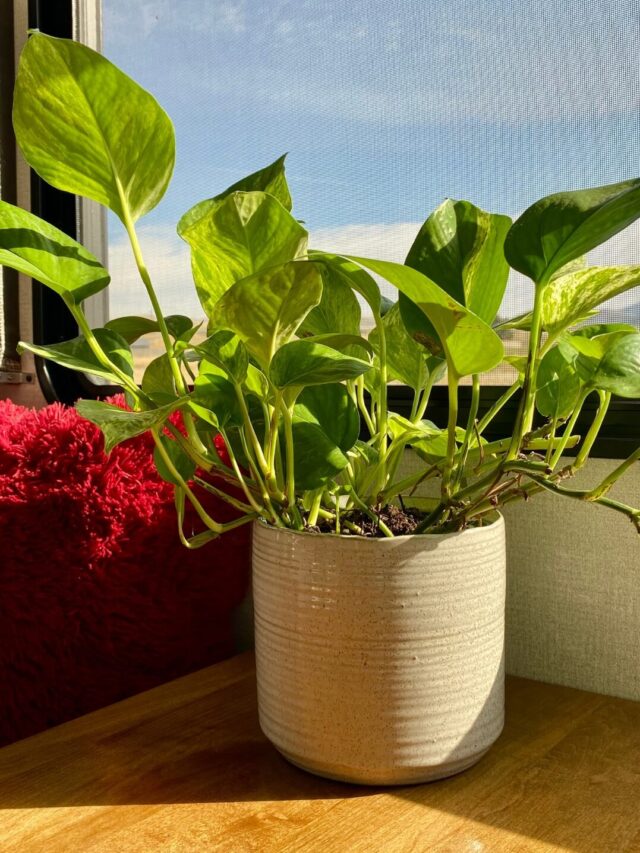If you’re looking to learn more about the best RV plants (and the worst), then you’ve come to the right place!
In this guide, you’re going to learn about plants that thrive in RV life, like Pothos and Snake Plants, as well as plants to avoid, like succulents and Bonsai Trees.
I’ve also included care instructions for each plant so you won’t have to guess what they need to thrive.
After living in an RV for over four years, I’ve tried a wide variety of RV plants and have learned what works and what doesn’t, so I’m excited to share my plant experiences with you!
So, without further adieu, let’s jump right in!
Plants that thrive in an RV
Alright, let’s start off with the very best plants for a full-time RVer to grow!
Not only are these plants easy to grow in an RV, but they’re also great for RV decorating.
1. Pothos
Of course, I have to start this list off with my very favorite RV plant. The pothos!
The Pothos plant, scientifically known as Epipremnum aureum, is ideal for beginners and those with a less-than-green thumb.
It’s also known by various common names, such as Devil’s Ivy, Golden Pothos, and Silver Vine, among others.
This plant is my favorite because it is easy to keep alive and looks beautiful in almost any space!
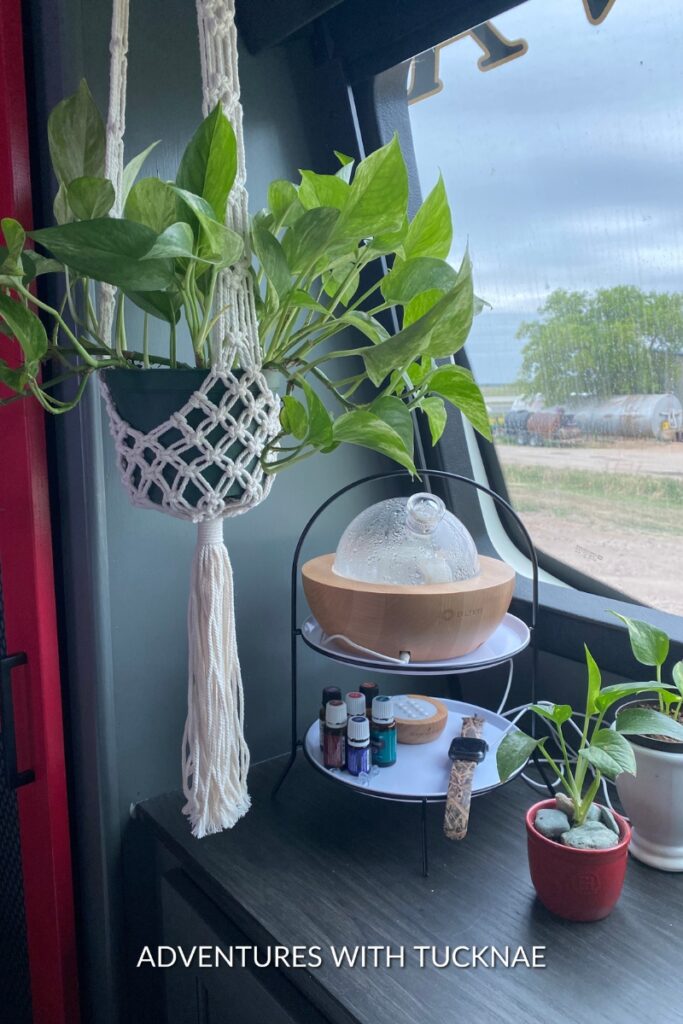
I have owned quite a few pothos plants over the past several years, and the only thing I have personally found to kill them is really cold temperatures.
While our RV was unattended for two nights, the propane ran out and the temps inside the RV dropped. When we got back, nothing was harmed except for my plants.
But as long as you can keep them in regular temperatures, you should be fine!
While it is better to underwater rather than overwater a Pothos, they are very dramatic and can look extremely wilted when they want a drink.
As soon as you water them though, they perk right back up and look happier than ever!
Pothos don’t require much sunlight, so you can put them anywhere in your RV, which is really nice.
Another great benefit of having a Pothos plant is that they are great for air purification!

Pothos Care Instructions
- Light: Pothos prefers indirect light but is highly adaptable and can thrive in low-light conditions as well. However, variegated varieties may lose some of their leaf patterns in too little light.
- Water: Allow the soil to dry out between waterings. Overwatering can lead to root rot, so it’s better to err on the side of underwatering.
- Soil: It isn’t picky about soil as long as it’s well-draining. A standard potting mix works fine.
- Feeding: You can fertilize your Pothos monthly during the spring and summer with a balanced, all-purpose liquid fertilizer, but it’s not necessary for the plant to thrive.
- Pruning: Regular pruning helps keep the plant bushy and full rather than leggy. The cuttings can easily be propagated in water!

2. Spider Plant
Moving on, another one of my favorite plants is the spider plant, even though it has a very unfortunate name, haha!
The Spider plant, scientifically known as Chlorophytum comosum, is another very popular indoor plant option that’s easy to care for.
Other common names include Airplane Plant, Spider Ivy, and Ribbon Plant, just to name a few.
This is a great plant for both beginners and avid plant lovers alike!
My personal favorite thing about the Spider plant is how easily it propagates.
Healthy and happy Spider plants put off baby plants called “pups” or “spiderettes” that hang from the mother plant on long stems, resembling spiders on a web, hence the name.

Sometimes, a mother plant can have dozens of pups on it at a single time! When the pups are grown enough, they will develop roots.
When they are ready, you simply cut the pup off of the mother plant with scissors and plant it in its own pot. It’s so easy!
I currently have multiple mother Spider plants that need to have their pups removed, and I plan to give them away to friends and family since there are so many, haha!
Just like the Pothos, Spider plants are known for improving air quality, so these are great plants to have in your travel trailer.
Spider Plant Care Instructions
- Light: Spider plants prefer bright, indirect light but can tolerate lower light conditions. However, too much full sun can scorch their leaves.
- Water: They prefer evenly moist soil but are quite forgiving if you occasionally forget to water them. It’s crucial to let the soil dry out somewhat between waterings to avoid overwatering and root rot.
- Soil: Any well-draining potting mix will do. They’re not particularly fussy about their soil.
- Feeding: Feed with a balanced, water-soluble fertilizer about once a month during the spring and summer. Reduce feeding in the fall and winter months.
- Humidity: Spider plants enjoy moderate to high humidity but can tolerate average household humidity levels.

3. Aloe Vera
If you have owned houseplants in the past, then chances are, you might be familiar with the Aloe plant.
Aloe Aera, scientifically known as Aloe barbadensis miller, is a succulent plant species from the genus Aloe.
Not only is it a beautiful plant, but it also has medicinal properties, particularly the gel inside its leaves, which is used for healing and soothing burns, cuts, and other skin problems.
Aloe Aera is also popular because it’s a generally low-maintenance plant.

Most people don’t have any issues with Aloe, however, I seem to be one of the unlucky few that do, haha!
Most of my first Aloe Vera plants would die, but *fingers crossed* I think I finally have figured them out, and I currently have two that are very happy and healthy!
When these plants are thriving, they really are beautiful! I love how vibrant the green leaves get.
There are multiple varieties of Aloe plants, but my favorite one is the Aloe Vera.
Aloe Vera Care Instructions
- Light: Aloe Vera thrives in bright, indirect sunlight. It can tolerate some direct sunlight, but too much can cause the leaves to brown.
- Water: Water deeply but infrequently, allowing the soil to dry out completely between waterings. Overwatering is a common mistake that can lead to root rot.
- Soil: Use a well-draining potting mix designed for cacti and succulents.
- Feeding: Feed with a balanced fertilizer designed for succulents, but only sparingly, about once in the spring and again in the summer.
- Temperature: It prefers warmer temperatures but can survive in temperatures as low as 50°F (10°C). In the winter, keep it away from drafty windows.
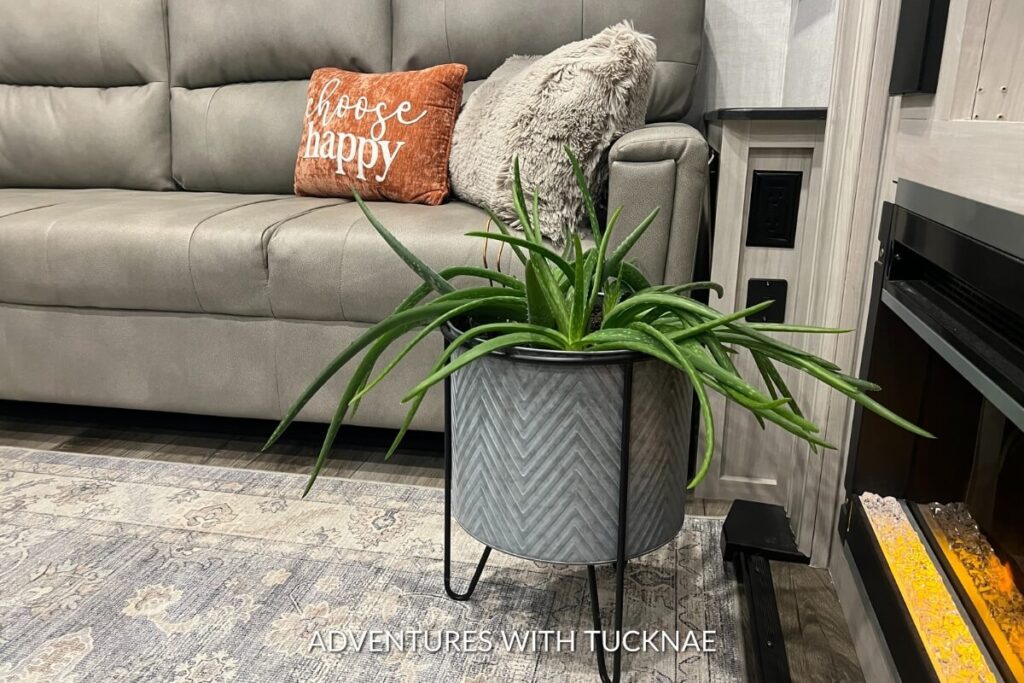
4. Hoya
The Hoya plant, scientifically known as Hoya carnosa, and often referred to as the wax plant due to its waxy leaves and flowers, is a diverse genus of tropical plants.
It is popular for RVers to own this plant because of how beautiful it is and how relatively easy it is to care for.
There are over 200 species of Hoya plants, which can vary significantly in leaf shape, size, and flower color, but they all share the same common care needs.
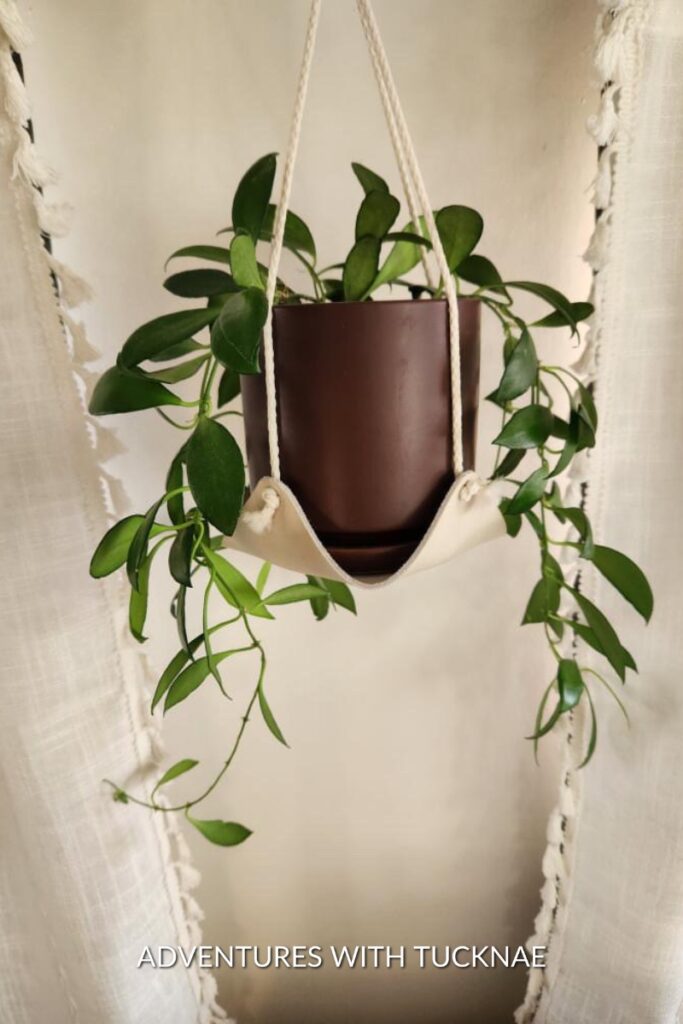
I just recently got my first Hoya plant, but my RV friends Victoria and Mandy have both had great luck with growing Hoyas in their RVs over time.
As you know, if you live in an RV, there is limited space, so you kind of have to pick and choose which light-hungry plants you want to have, haha!
So I waited for a bit, but this plant was on my list because I love how beautiful they are, especially when they bloom!
Hoya plants are known for their waxy, thick green leaves and stunning, star-shaped flowers that often appear in beautiful clusters.
The beautiful flowers can be fragrant, especially at night, and come in a variety of colors, including pink, white, yellow, and red.
I hope that my Hoya plant is happy enough to bloom in the future!
Hoya Care Instructions
- Light: Hoyas prefer bright, indirect light. Some varieties can tolerate direct morning sunlight, but too much direct light can scorch their leaves.
- Water: Allow the soil to dry out somewhat between waterings. Hoyas do not like to be overwatered and have semi-succulent qualities, meaning they can store water in their leaves. Water less frequently in the winter.
- Soil: Use a well-draining potting mix. Adding perlite or orchid bark to regular potting soil can improve good drainage.
- Humidity: Most Hoyas prefer higher humidity levels but can adapt to average household humidity. Mist the plants occasionally or use a pebble tray to increase humidity.
- Feeding: Feed with a balanced, water-soluble fertilizer every 4-6 weeks during the growing season (spring and summer). Reduce feeding in fall and winter.

5. Snake Plants
Another one of my favorite RV plants, once again with an unfortunate name, is snake plants!
Snake plants, scientifically known as Sansevieria, are one of the most resilient and low-maintenance indoor plants, making them a popular choice for RVers.
Some of the other common names for this plant are Mother-in-law’s Tongue, Saint George’s Sword, and Good Luck Plant.
While I love pothos because they trail out and get long vines, I equally love snake plants for the opposite reason.
Snake plants grow straight up and can grow very tall, even reaching heights of over 12 feet tall!
Of course, that takes many years, so you’re safe having them in a small RV for awhile still, haha!

Snake plant leaves can vary in color from dark green to light green and often have yellow or white edges.
The leaves have a thick, waxy coating that helps retain moisture.
They are also among the top plants for filtering out toxins from the air, as noted in a study by NASA!
They are particularly good at converting CO2 into oxygen at night, making them an excellent plant to put in RV bedrooms.
Snake plants can be easily propagated through leaf cuttings or by dividing the plant during repotting.
To propagate from cuttings, cut a leaf into segments and plant the segments in soil, making sure to keep the original orientation of the leaf segment upward.
It can take a few weeks to months for the cuttings to root and establish, and I personally haven’t had great luck so far with propagating mine.
Snake Plant Care Instructions
- Light: Snake plants are very adaptable and can thrive in a wide range of lighting conditions, from low light to direct sunlight. However, they prefer indirect sunlight.
- Water: They require minimal water. Allow the soil to completely dry out between waterings. Overwatering is the most common issue with snake plants, leading to root rot.
- Soil: Use a well-draining potting mix, preferably one designed for cacti or succulents.
- Temperature: They prefer warmer environments but can tolerate temperatures as low as 50°F (10°C). Avoid placing them in areas with cold drafts.
- Feeding: Fertilize sparingly with a general-purpose plant food a few times during the spring and summer. Over-fertilization can harm the plant.
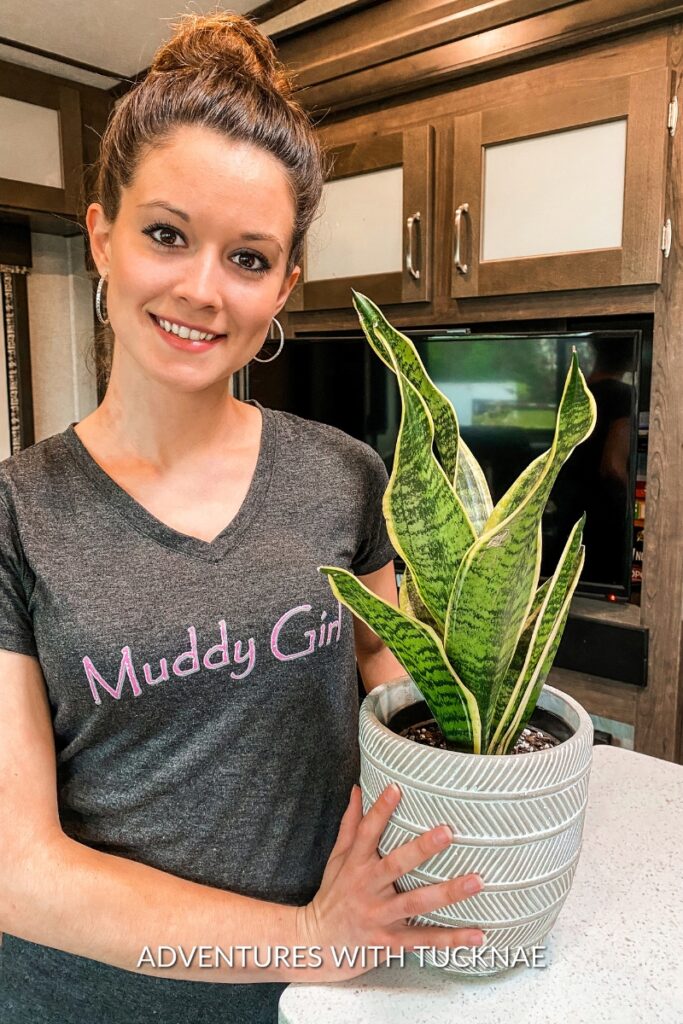
6. Air Plants
Air plants, scientifically known as Tillandsia, belong to the bromeliad family and are fascinating plants that don’t need any soil to grow!
They have gained immense popularity recently due to their unique appearance and minimal care requirements.
Air plants absorb moisture and nutrients through their leaves from the air, using their roots only for anchoring themselves to hosts such as rocks, trees, or even within terrariums.
These plants have always intrigued me, so recently, I got a few of them for our RV bathroom!
I’m happy to report that so far, so good, and they are doing well.

These plants are so intriguing to me since they don’t need soil and can basically thrive anywhere.
I put mine in a cute decorative planter that I hung on the wall, and I take them out of the planter to soak them in water 1-2 times a week.
Air plants are versatile and can be displayed in lots of creative ways, such as mounted on driftwood, placed in terrariums, or simply set on top of a decorative dish.
I can’t wait to collect even more of these fun plants over time!
Air Plant Care Instructions
- Light: Air plants prefer bright, indirect light. A spot near a window where they receive filtered sunlight is ideal. Avoid direct, harsh sunlight, especially during the hottest part of the day.
- Water: Soak your air plants in room-temperature water for 20-30 minutes once a week. Shake off any excess water and let them dry completely in a well-ventilated area before placing them back in their spot. Increase watering to twice a week in hot, dry conditions. You can also periodically mist them with a spray bottle.
- Air Circulation: Good air circulation is crucial for air plants to thrive. After watering, ensure they are thoroughly dried to prevent rot.
- Temperature: They prefer warm temperatures between 50-90°F (10-32°C) and should be protected from cold.

7. ZZ Plants
The ZZ Plant, or Zamioculcas zamiifolia, has become a staple in homes all around the world for its beautiful appearance and hardy resilience.
The ZZ Plant is native to Eastern Africa and is well-suited for indoor environments, thanks to its ability to thrive under low light conditions and its minimal water requirements.
I got my first ZZ plant a little over a year ago, and I have to say, it’s become one of my very favorite plants!
Not only is it absolutely adorable, but it’s been such an easy plant to care for, and so far, it hasn’t given me any trouble.

ZZ plants have shiny, waxy leaves that are dark green in color, which grow on stems that can get quite tall in the right conditions.
There are also variations that are a darker, almost black color, and those are my personal favorites.
The most common variety is green, though, and those leaves reflect sunlight, adding a bright, lively touch to your RV.
ZZ plants are slow growers, but given time, they can reach a substantial size, up to 2-3 feet indoors.
Fun fact: The ZZ plant grows from rhizomes, which are underground plant stems that store water, helping the plant survive drought conditions!
ZZ Plant Care Instructions
- Light: ZZ plants can tolerate low light but thrive in bright, indirect sunlight. They can survive in areas where natural light is scarce, but growth may be slower without enough light.
- Water: Overwatering is the biggest risk to ZZ plants. Let the soil dry out completely between waterings. During winter, reduce watering frequency as the plant’s growth slows down.
- Soil: Use a well-draining potting mix to prevent water from accumulating around the roots.
- Temperature: ZZ plants prefer temperatures between 60°F (15°C) and 75°F (24°C). They can tolerate a range but should be protected from extreme cold.
- Humidity: Average household humidity is sufficient for ZZ plants; they do not require extra humidity.
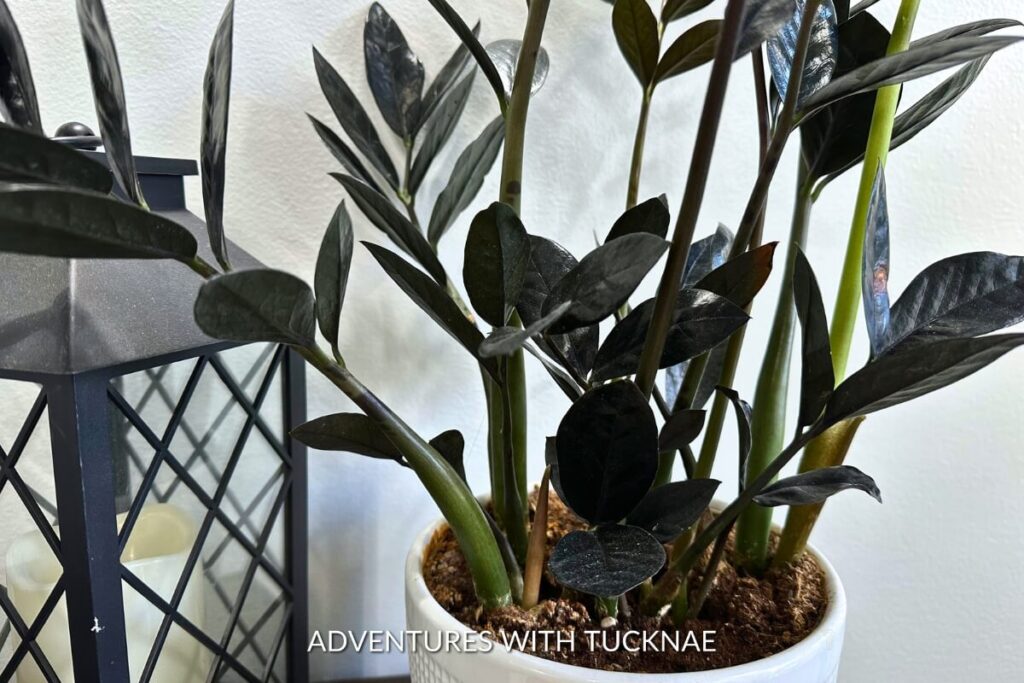
8. Philodendron
Another great plant for RV travel life is the Philodendron!
The Philodendron genus includes a large group of plants, known for their lush foliage and adaptability, making them great for RVers.
These tropical plants, native to the rainforests of South America, come in two main types: climbing (vining) and non-climbing (upright, self-heading) varieties.
Philodendrons are not only beautiful but once again, they’re also great at purifying the air in your RV.
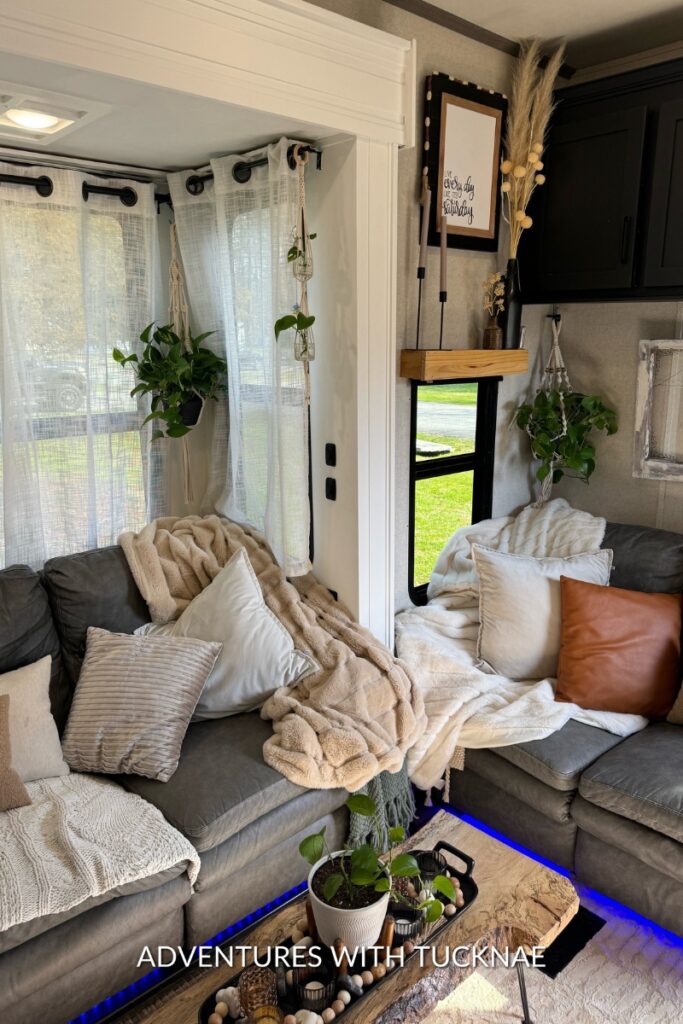
I personally love the vining Philodendrons and love to hang them in corners.
Philodendrons come in different sizes, leaf shapes, and colors, ranging from deep green to vibrant reds and even variegated patterns.
The climbing varieties often have heart-shaped leaves, and the non-climbing types can have large, split, or deeply lobed leaves.
Philodendrons can also be easily propagated through stem cuttings!
For the vining types, cut a piece of stem with at least 2-3 leaves and a few nodes and place it in water or directly into the soil.
For the non-climbing types, it’s best to divide them when you repot them.
Philodendron Care Instructions
- Light: Philodendrons prefer medium to bright, indirect sunlight. Variegated types may require more light to maintain their unique patterns. Direct sunlight can scorch their leaves, while too little light can lead to leggy growth and fewer leaves.
- Water: Allow the top inch of soil to dry out before watering again. Overwatering can lead to root rot, so it’s crucial to ensure proper drainage. They prefer a consistent watering schedule but are forgiving if you occasionally forget.
- Soil: A well-draining potting mix is ideal. You can mix in some peat moss or perlite to improve drainage and aeration.
- Humidity: As tropical plants, philodendrons thrive in higher humidity but can adapt to average household humidity. Misting the leaves or using a pebble tray can help increase humidity levels.
- Feeding: Use a balanced liquid fertilizer every 4-6 weeks during the growing season (spring and summer). Reduce feeding in the fall and winter when growth slows.

9. English Ivy Plants
Another plant that is perfect for RV owners to grow in their RV is English Ivy.
English Ivy, scientifically known as Hedera helix, is an evergreen vine that makes a great indoor houseplant.
This plant is native to Europe and western Asia but has been widely introduced elsewhere, including North America, where it is often used for decorating.
English Ivy has dark green leaves that are lobed and can be various sizes.
This plant grows very fast, and it can be trained to grow on trellises or also hang from baskets.
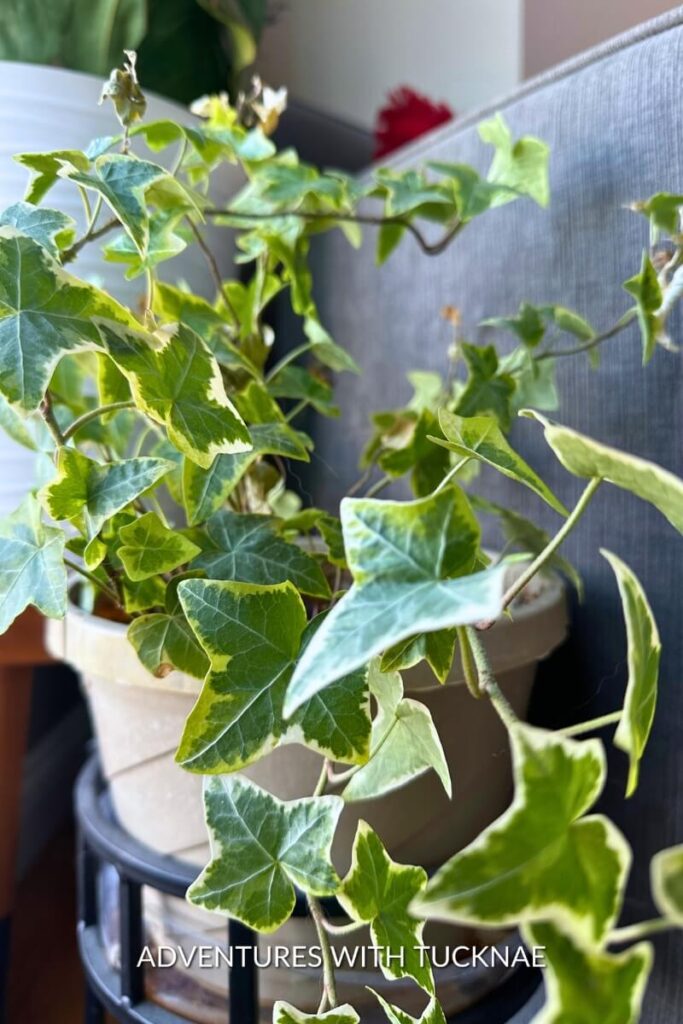
Propagation is fairly easy with English Ivy, which is another reason this plant is a great option.
You can start new plants by taking stem cuttings, placing them in water until roots develop, and then potting them.
English Ivy Care Instructions
- Light: English Ivy prefers bright, indirect light but can tolerate low light. Variegated varieties may require more light to maintain their patterning.
- Water: Keep the soil evenly moist during the growing season (spring and summer) and reduce watering in the fall and winter. Allow the topsoil to dry out slightly before watering again.
- Soil: Use a well-draining potting mix to prevent waterlogging and root rot.
- Humidity: It thrives in a range of humidity levels but prefers higher humidity if possible. Misting the leaves or using a pebble tray can help increase humidity around the plant.
- Temperature: English Ivy prefers cooler temperatures, ideally between 50-70°F (10-21°C), and should be protected from hot, dry air.
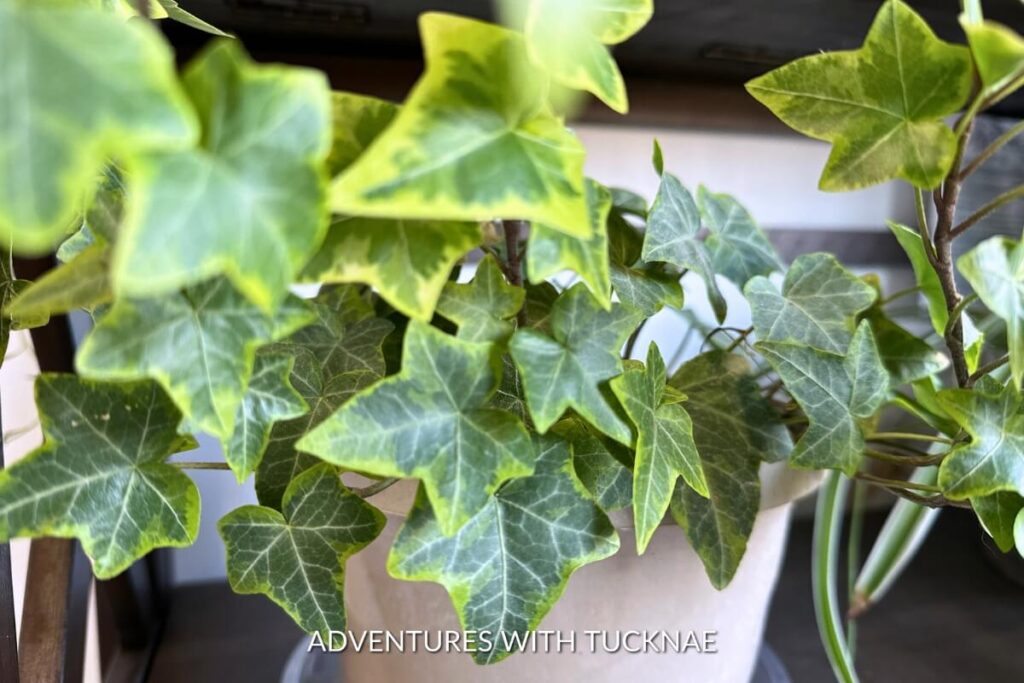
10. Ponytail Palm Tree
The Ponytail Palm Tree, scientifically known as Beaucarnea recurvata, is not a true palm, but rather, it is related to agaves and yuccas.
This plant has become popular recently because of its unique appearance and how easy it is to care for.
One super cool thing about the Ponytail Palm is its water-storing capabilities in its bulbous base!
I rescued my first Ponytail Palm Tree years ago, laying on the ground at a Walmart garden center and bought it to try and save.
That was seven years ago, and it’s still alive and well, and I’ve since gotten a second one!
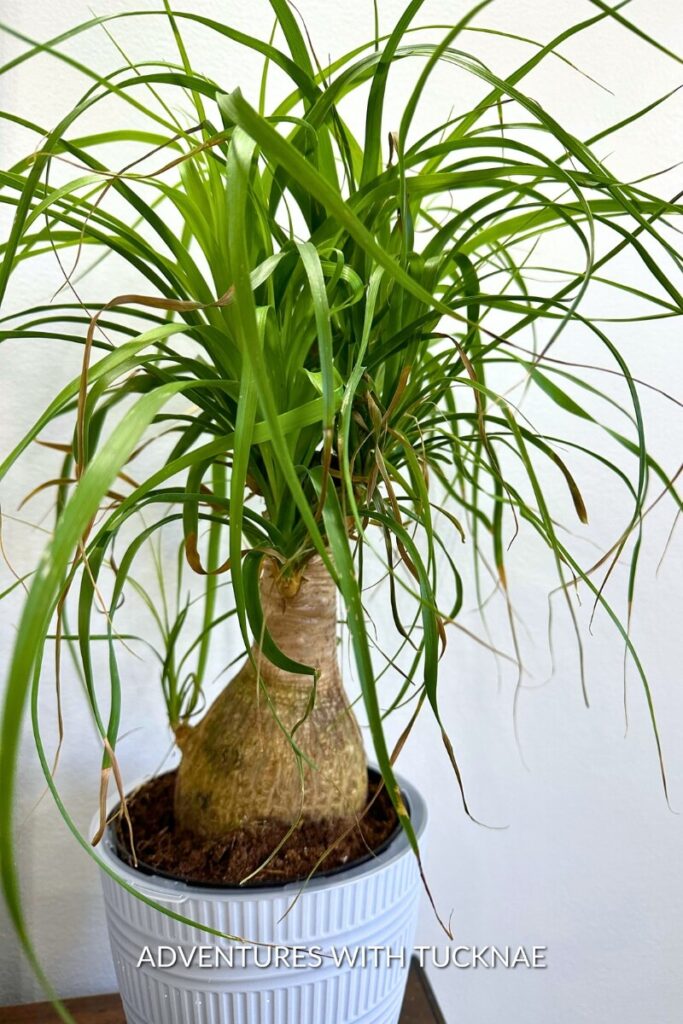
The Ponytail Palm plant grows slowly, and when grown indoors, it typically remains small, making it an excellent houseplant for RVers.
This plant is extremely tolerant of dry conditions and is an excellent choice for those who might occasionally forget to water their plants.
(Yes, I am occasionally that person, too. Haha!)
Ponytail Palm Care Instructions
- Light: The Ponytail Palm prefers bright, indirect light but can tolerate some direct sunlight.
- Water: Water sparingly, allowing the soil to dry out completely between waterings. The bulbous base stores water, enabling the plant to withstand periods of drought. Overwatering is the biggest risk and can lead to root rot.
- Soil: Use a well-draining potting mix, ideally formulated for succulents or cacti, to prevent water from accumulating around the roots.
- Temperature: It prefers warmer temperatures but is relatively adaptable. Keep it away from cold drafts, especially in the winter months. It thrives in temperatures between 60°F and 80°F (15°C to 27°C).
- Feeding: Fertilize sparingly with a balanced, water-soluble fertilizer during the growing season (spring and summer), reducing feeding in the fall and winter.
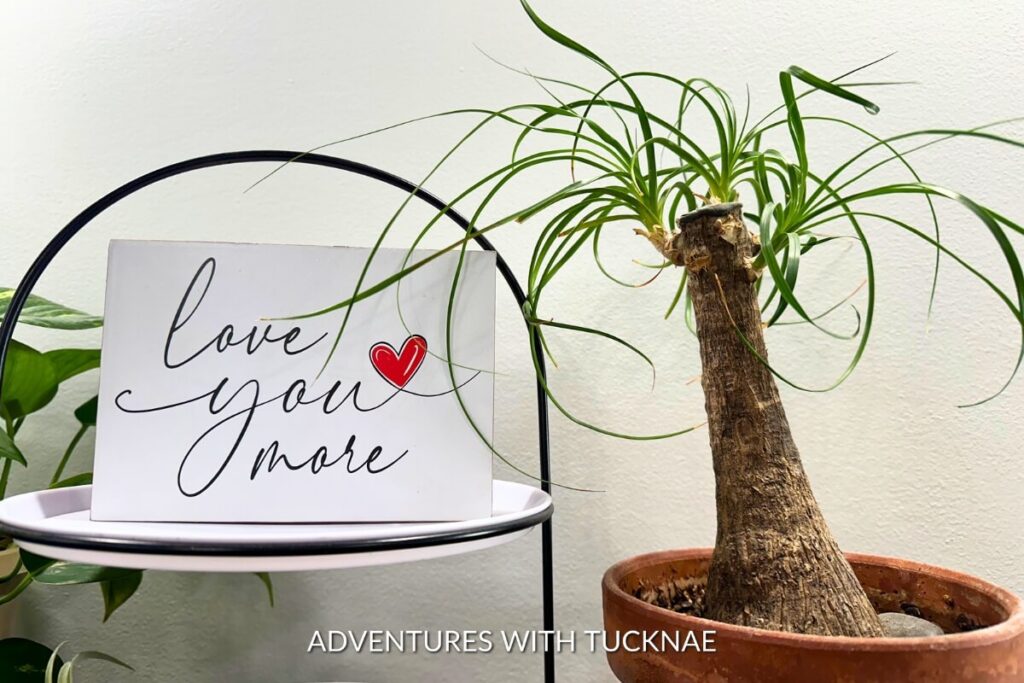
Plants that are NOT good for RVers
Now that we’ve gone over the best plants to grow in an RV let’s cover a few that you should probably avoid.
An RV lifestyle involves movement and varying levels of humidity and light, which can be challenging for some plants.
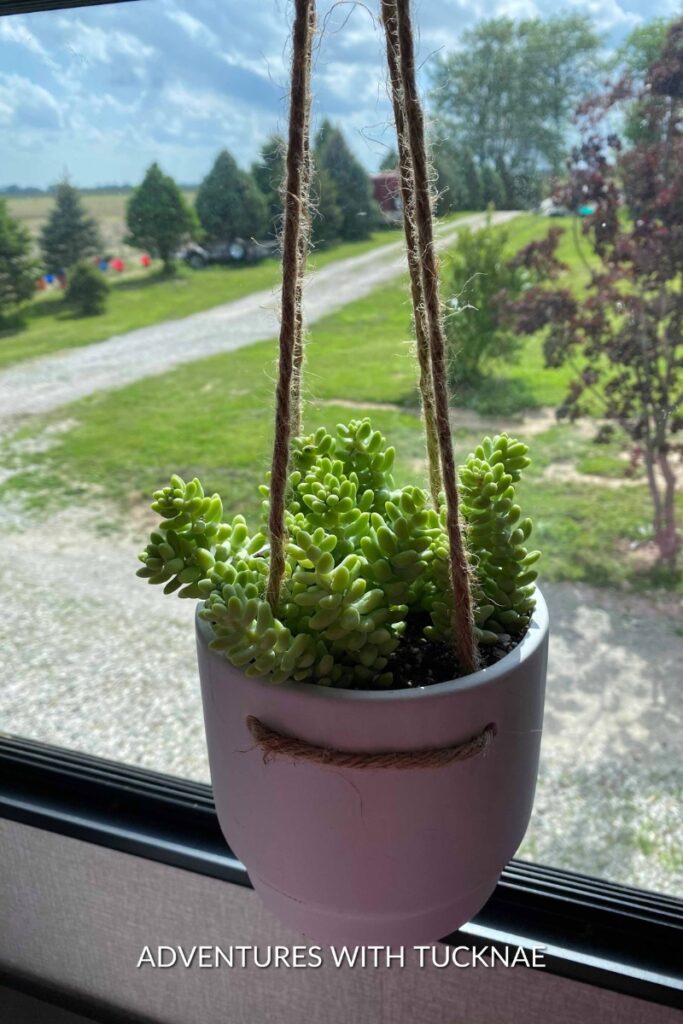
Fiddle Leaf Fig
This trendy plant requires stable conditions to thrive, including consistent, bright, indirect light and steady humidity levels.
The frequent movement, fluctuating temperatures, and variable light conditions in an RV can stress the plant, leading to leaf drop and stunted growth.
While this is one of my favorite house plants, it’s sadly not suited to RV life.
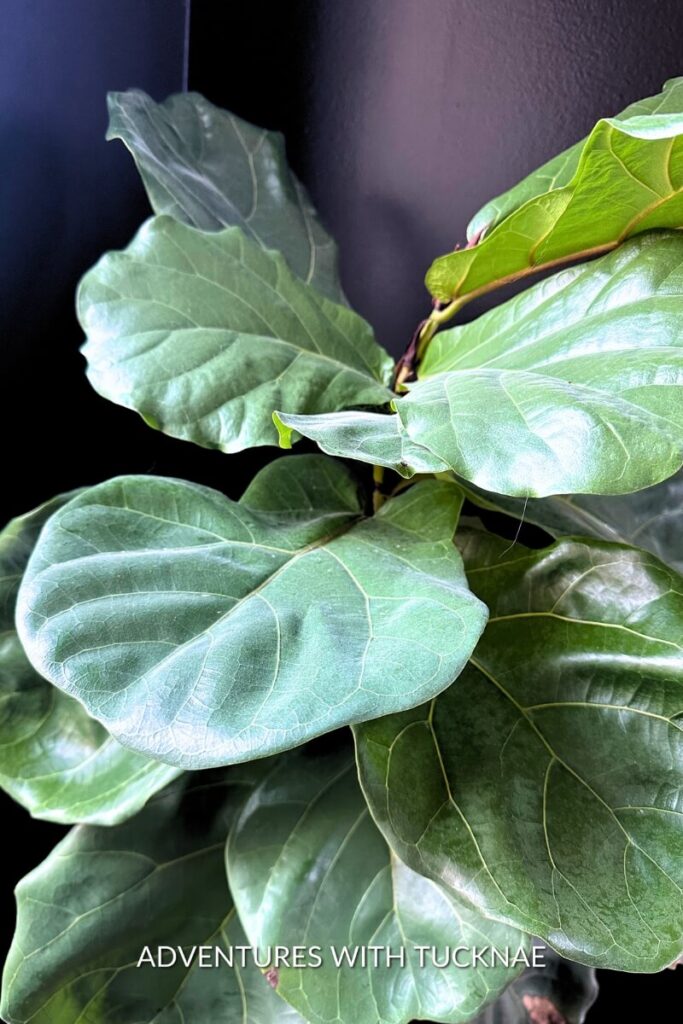
Succulents
Echeverias are popular succulents that require ample sunlight to maintain their color and compact rosette shape.
In an RV, finding a consistently sunny spot without direct, scorching light can be challenging.
Additionally, the limited airflow and potential for overwatering in an enclosed space can lead to rot.
Trust me, I’ve tried many times to keep succulents alive in our RV, and sadly, it just doesn’t ever work out, haha!

Peace Lily
The Peace Lily prefers stable humidity and indirect light, which can be challenging to maintain in an RV’s fluctuating environment.
Its sensitivity to temperature changes and drafts can lead to stress and decline, which is common in an RV.
Also, peace lilies have the need for consistent soil moisture without overwatering, which requires a level of attention that might be difficult to keep up with when you’re constantly on the move.
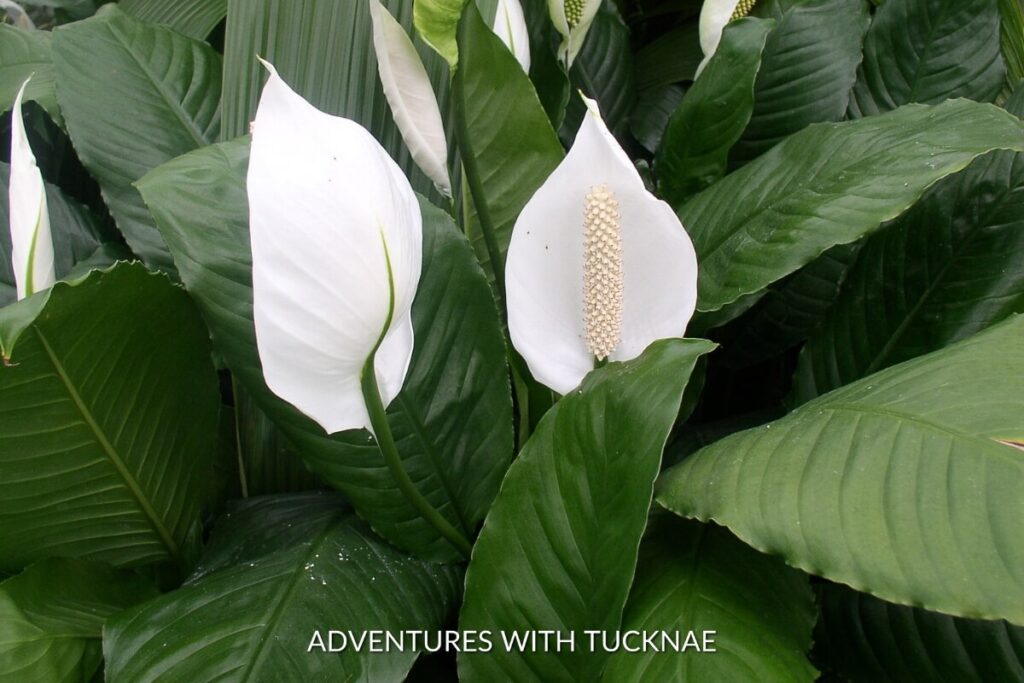
Bonsai Trees
Bonsai trees require meticulous care, including specific watering, pruning, and lighting conditions, making them less than ideal for the often unpredictable conditions of RV living.
Honestly, I’ve found these plants fairly difficult to take care of, no matter if you’re in an RV or not.
If you don’t have a green thumb, it’s probably best to avoid Bonsai altogether.

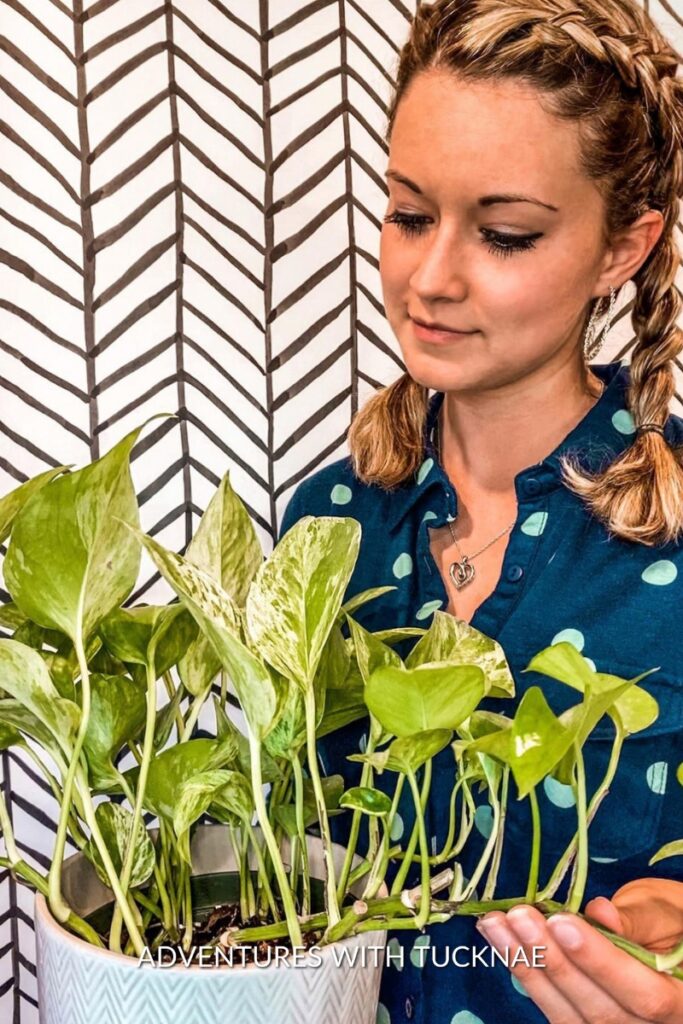
In Closing: The Best RV Plants to Grow in an RV
I hope that you’ve found this RV plant guide helpful and that you’ve got a list of plants you want to get now.
Comment below and let me know what plants you’ve added to your wish list!
Find More RV Tips & Advice
- Advice to Newbie RVers from 32 Full-Time RVers
- 8 Tips to Prepare for RV Travel Days
- 21 Unique Jobs for Full-Time RVers
- 7 Important RV Living Safety Tips
- RV Tip: How To Keep Glass Plates From Breaking in an RV
- Winter RV Camping Guide: 13 Tips for RVing in Cold Weather
- Easy RV Hot Water Heater Maintenance Guide + Cleaning Tips
- 101 Inspirational RV Quotes & the Best RV Camping Captions
- The 60+ Best RV Games For Indoor & Outdoor Camping Fun
- A Full-Time RVers Complete Guide to RV Laundry Solutions
- 10 of the Best RV Plants to Grow in an RV
Safe travels!

